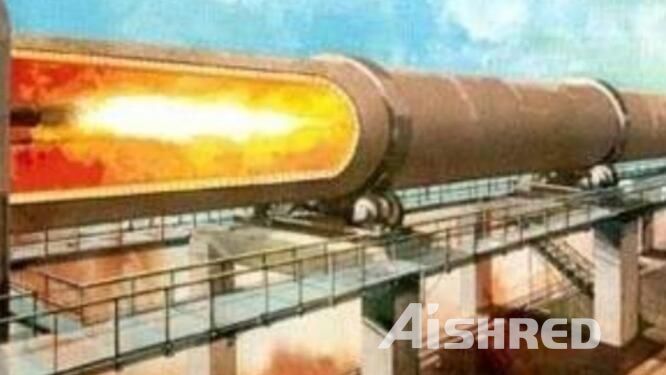Conventional fuels like hard coal and lignite that are commonly used fuels in cement production have high specific CO2 emission values (Hard coal: ~95 kg CO2/GJ; Lignite: ~98 kg CO2/GJ). Consequently, substituting these with other fuels having lower specific emssion values (e.g. fuel oil or natural gas) or with other sources that can satisfy the thermal demand of the processes is an effective way of reducing CO2 emissons.
Principally, in cement kilns conventional fossil fuels can be substituted up to 100% by alternative fuels. Nevertheless, there are certain technical limitations like the calorific value, the moisture content, and the content of side products like trace elements or chlorine. The calorific value of most organic material is comparatively low (10 – 18 GJ/t). For the main firing of the cement kiln an average calorific value of at least 20-22 GJ/t is required, meaning that high calorific alternative fuels are mostly used in the main firing.
Waste tyres can be used as a fuel in cement kilns. Waste tyres can be used as a fuel in a solid form either as they are or after being shredded. Depending on the process and plant configuration, tyres can be fed directly to the kiln, or can be used as a fuel supplament in the calciner.
The chemical compositions of various tires are very identical and Rubber is the main part of the tire, so this characteristic facilitates using of tires as an alternative fuel in cement production industries. Waste tires are identified as a compact fuel with low humidity which consists of 90 % of hydrogen, carbon and oxygen with thermal value 32 MJ/Kg. Table 1 shows the chemical composition, thermal value of waste tires and main fuels used in Iran cement industry. According to EPA (Environment Protection Agency of USA) previous reports of 60 cement plants in USA used 53.000.000 waste tires as alternative fuel.
| Composition | Natural gas % | Fuel Oil % | Tire % |
| Humidity | 0.2 | 1 | 0 |
| Carbon | 80.1 | 83.8 | 78.2 |
| Hydrogen | 14.3 | 11.2 | 7.1 |
| Sulfur | 4.5 ppm | 3.9 | 1.6 |
| Nitrogen | 5.3 | 0.1 | 0.2 |
| Zinc Oxide | 0 | 0 | 0.9 |
| Steel | 0 | 0 | 12 |
| Thermal Value | 36.6 (Mj/Nm3) | 41.7 (Mj/Kg) | 37.6 (Mj/Kg) |
| Table1. Chemical Composition and Thermal Value | |||
The thermal value of waste tires differ depending upon type and amount of consisting fiber and steel materials. Also the very low amount of contaminating elements such as nitrogen and sulfur is another advantage of using waste tires as an alternative fuel in cement production process. According to the recent studies waste tires burn fast at the temperature range of 300 c to 350 c then by increasing temperature to 400 c the carbon part of tires start to burn and finally at the temperature of 650 c burning process of carbon is completed. As a theoretical calculation the thermal value of 1 kg tire is equivalent to 0.86 liter of oil.
Cement kilns are suitable environment for burning alternative fuel. Because cement kiln have long length and high temperature around 1500 ℃ with long retention time Figure 1 shows the cement kiln use waste tire as alternative fuel.

Depending on the kiln system, the following rules should take to consider regarding to chip size and potential for substitution to ensure success: Smaller the chips size provides more substitution rate and produced more efficiency. The best chips size in short kiln size is about 25 x 25 mm chip size or smaller. Premixing the chips with cement raw materials recommended in preheating kilns because for complete combustion of chips and breaking strong organic bond in hydrocarbon chain via main flame in main rotary kiln. For long kilns without pre heating, the chips need to be blown to the back of the burning zone. Ideally, the injection pipe should be located above the main burner, at a 5-10 degree angle, so the main flame can carry the chips further and start the volatilization prior to the chips striking the load. Finally, impact of raw materials on SO2, CO, VOC, D/F’s needs to be fully understood and tracked, prior to co-processing any chips on the other hand [4, 20]. Application of waste tire affect on produced clinker. It would be necessary to study the effect of elements such as inorganic elements such as Sulfur, Iron and Zinc on produced cement.
Sulfur: According to high concentration of sulfur in tire composition, and tendency of production of volatile alkaline salts in this environment, Solid layer form in inlet and outlet of cement kiln.
Iron: Iron contained in tire melts and reacts with aluminum in cement kiln. This results in decreasing concentration of aluminum in cement composition. So it would be necessary to add aluminum compounds to the raw materials.
Zinc: Zinc presents with high concentration in tires. 1 to 2 percent of tire weight is zinc oxide. If the concentration of zinc in clinker is lower than 500 ppm it would not affect on cement properties. Substitution rate of waste tire in cement industry is 25% of total required energy. If rate of substitution is more than 25%, time of production of clinker will greatly increase.
GEP ECOTECH Provide Pre-Processing System for Waste Tires to Alternative Fuels.

